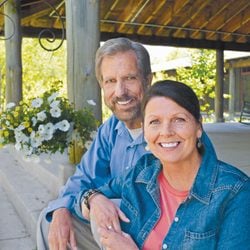How to Identify a Wood Thrush
Updated: Apr. 16, 2024
Learn where to spot a wood thrush. These shy brown birds have a captivating song and hunt for insects on the forest floor.
On This Page
What Does a Wood Thrush Look Like?
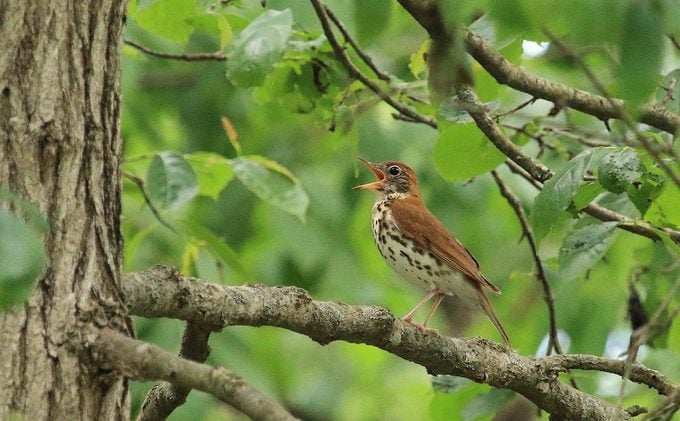
There are very few birds with songs that can rival the dreamy notes and complex trills of the wood thrush. These forest-dwelling birds can be hard to spot. Their field markings give them great camouflage that allows them to blend in with their surroundings.
“Most often you’ll hear them and not see them,” says Zach Ladin, an ecologist for U.S. Fish and Wildlife Service. Thrush species, including wood thrush, are known for their dreamy, flute-like song and complex trills. “For this reason, identifying wood thrushes by their song is a great method,” Zach says.
But if you are on the search, it’s easiest to spot them on the ground. Wood thrushes are medium-sized birds and larger than other thrush species, like hermit and Swainson’s thrushes. Both male and female wood thrushes have dark, bold spots on their chests and rich, cinnamon coloring on their backs and heads. Their large eyes help them spot bugs in thick, shady forests.
Learn to identify more small brown birds you might see.
Wood Thrush Habitat and Range
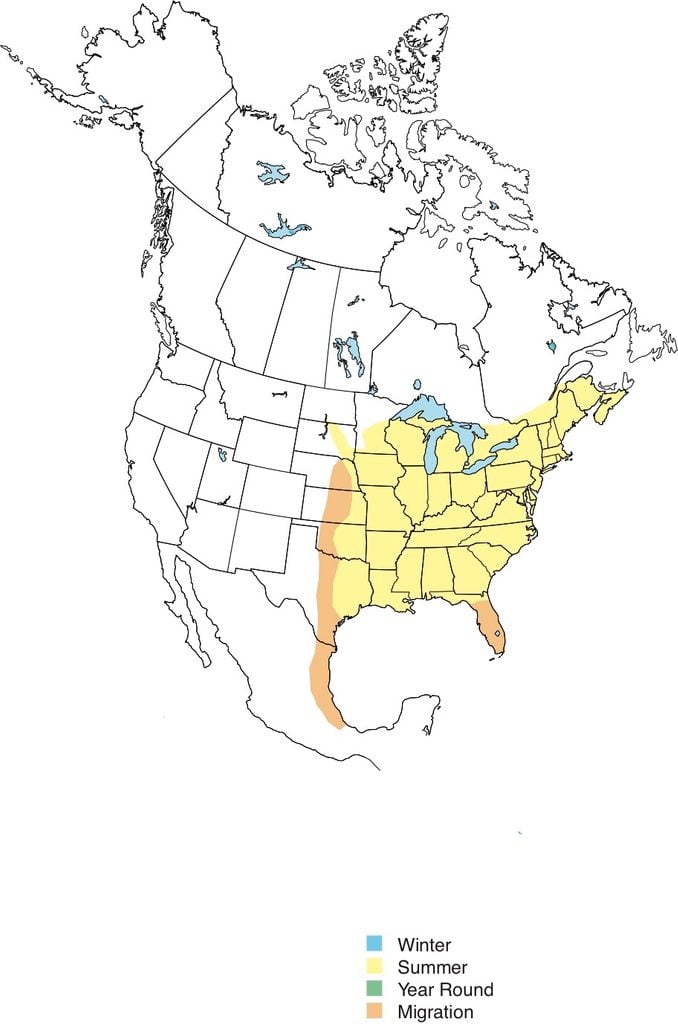
Range maps provided by Kaufman Field Guides, the official field guide of Birds & Blooms.
Wood thrushes live in the Midwest and eastern U.S. and stick to deciduous and mixed forests with dense undergrowth during their breeding season from May to August. When the weather gets colder, they head south to Central America.
Although wood thrushes are considered a common bird, their numbers have been declining since the 1950s due to loss of habitat and forest fragmentation.
“When forest habitat is reduced, there may be less food available and an increase in negative effects from predators and nest parasitism from brown-headed cowbirds,” says Zach. “We must take a holistic approach and work with international partners to protect habitats. We can protect those areas for birds and protect critical ecosystems that support life on Earth for humans — it’s a win-win.”
Learn how to identify a varied thrush.
Nesting Habits
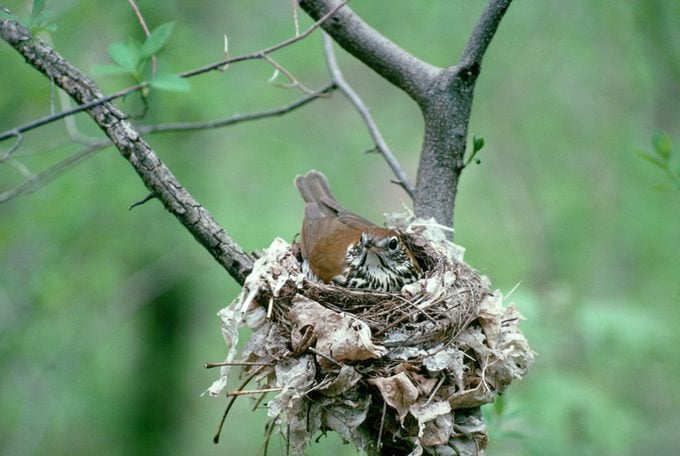
“Wood thrushes tend to build their nests in the forks of branches of understory shrubs or young trees,” says Zach. “On average, nest height is around 13 feet high but can range between two feet and over 90 feet from the ground.” The male finds and establishes the breeding ground. After courtship activities, like mutual feeding, the female selects the nest site.
Their nests are cup-shaped and lined with leaves, grass and, similar to American robins, a layer of mud. Sometimes they incorporate manmade materials, like cellophane and bits of paper, into the nest structure, too. Each nest holds three to four eggs.
A pair of wood thrushes will usually raise two broods per season in two separate nests. (Both parents feed the fledglings at first, and then the male continues feeding them after the female lays her next clutch of eggs.) Although wood thrush pairs raise their young together, they’re not monogamous. It’s relatively common for fledglings in a single brood not to share the same father.
One of the biggest challenges wood thrushes face during breeding season is contending with brown-headed cowbirds. This has been made worse by loss of habitat. “In a long-term study we conducted on wood thrushes in a fragmented landscape in Delaware, we found that despite having plenty of high-quality food, wood thrushes were negatively affected by brown-headed cowbirds, which lay their eggs in wood thrush nests,” Zach says.
Caring for and feeding the young cowbirds takes up the energy and time of the parent wood thrushes often at the fatal expense of their own young.
Diet: What Does a Wood Thrush Eat?
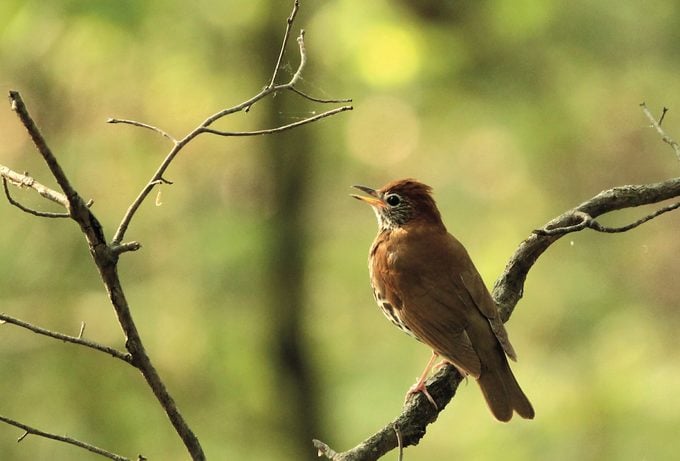
Wood thrushes hop along the forest floor and hunt for insects in the soil and under leaves. “They often forage in the leaf litter for invertebrates including snails and spiders,” says Zach. The shells of snails are an important source of calcium for female wood thrushes during breeding season. Small fruits and berries are also important items on the wood thrush menu, especially in late summer when they are preparing to migrate south.
However, if you’re hoping to attract wood thrushes to your backyard, you’re facing an uphill battle. “Wood thrushes are not your typical backyard bird, because they prefer mature forests with moderate understory vegetation,” says Zach. “But if you live on the edge of a forest or forest patch in the eastern U.S., you may have wood thrushes nearby during the breeding season.”
Wood Thrush Song
Bird sounds courtesy of the Cornell Lab of Ornithology
This species’ recognizable song is usually written out as ee-oh-lay but there’s a lot of complexity behind it. “Wood thrushes belong to a group of related thrush species that are known for having some of the most extraordinary songs in the bird world,” says Zach. “By passing wind through both sides of its vocal organ, called a syrinx, a wood thrush can generate its beautiful song with many overtones to create a rich, harmonic sound.” Essentially, it’s as though the bird is singing a duet with itself.
Because of all the different pitch and note variations available to these birds, a single male may sing up to 50 distinct versions of its song.
About the Expert
Zach Ladin is an ecologist who works in the Division of Migratory Birds in the U.S. Fish and Wildlife Service. He’s passionate about integrating ecological data and novel technologies to inform how humans can promote ecosystem health and function in light of increasing rates of global urbanization and climate change.
Sources
- National Geographic Backyard Guide to the Birds of North America: Jonathan Alderfer and Paul Hess
- All About Birds
- National Audubon Society
- American Bird Conservancy
- Smithsonian’s National Zoo & Conservation Biology Institute
Why Trust Us
For nearly 30 years, Birds & Blooms, a Trusted Media Brand, has been inspiring readers to have a lifelong love of birding, gardening and nature. We are the #1 bird and garden magazine in North America and a trusted online resource for over 15 million outdoor enthusiasts annually. Our library of thousands of informative articles and how-tos has been written by trusted journalists and fact-checked by bird and garden experts for accuracy. In addition to our staff of experienced gardeners and bird-watchers, we hire individuals who have years of education and hands-on experience with birding, bird feeding, gardening, butterflies, bugs and more. Learn more about Birds & Blooms, our field editor program, and our submission guidelines.

